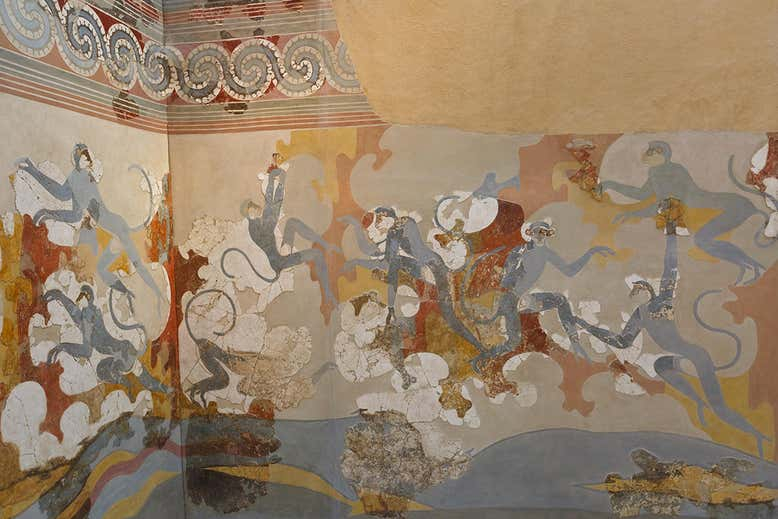A Bronze Age painting on a Greek island shows a monkey from thousands of kilometres away in Asia. The finding suggests that ancient cultures separated by great distances were trading and exchanging ideas.1
Many of the paintings show monkeys, yet there were no monkeys in Greece at the time. Most of the monkeys have been identified as Egyptian species like olive baboons. This makes sense because Egypt was in contact with the Minoan civilisation, which was spread across several Aegean islands. However, others were harder to identify.
Marie Nicole Pareja at the University of Pennsylvania in Philadelphia teamed up with primatologists to re-examine the mystery monkey paintings. One stood out. “When they looked at this wall painting, they all straight away unambiguously said ‘that’s a langur’,” says Pareja.
- 1. The artwork is one of several wall paintings in a building at Akrotiri on the Greek island of Thera (Santorini) in the Aegean Sea. Akrotiri was a settlement of the Minoan civilisation in Bronze Age Greece that was buried by ash from a volcanic eruption in around 1600 BC.
Pareja, M.N., McKinney, T., Mayhew, J.A. et al. A new identification of the monkeys depicted in a Bronze Age wall painting from Akrotiri, Thera Primates (2019).
doi: https://doi.org/10.1007/s10329-019-00778-1, © Japan Monkey Centre and Springer Japan KK, part of Springer Nature 2019
Bronze Age Aegean (ca. 3500–1100 B.C.) wall paintings from the islands of Crete and Thera depict monkeys in a variety of roles such as running wild in nature, possibly following (trained) commands, and participating in sacred activities. These images, while stylistically Aegean, are traditionally considered closely related to—and descendant from—Egyptian, Near Eastern, and Mesopotamian monkey imagery. While monkey depictions in the latter regions may provide species-specific characteristics, Aegean wall paintings typically lack this level of detail. In an attempt to better understand the relationships between the monkeys depicted in Aegean wall paintings and the species that were encountered by the Aegean, Mesopotamian, and Egyptian peoples, a collaborative team of primatologists, a taxonomic illustrator, and an art historian/archaeologist identified species-indicative visual characteristics. This collaborative approach led us to identify a new region that serves as a source for monkey iconography: the Indus River Valley. With an emphasis on the primatological aspect and the growing corpus of possible Indus goods and possible species found in the Aegean, a broader iconographic and socioreligious sphere of interaction emerges. In this expanded system, Mesopotamia functions as an intermediary that enables the movement of goods, raw materials, people, and iconography between the east and west. Mesopotamia may have even afforded an opportunity for Aegean peoples to encounter the creatures themselves, first-hand. Of primary importance to the methodology employed for this project is the cooperation of scholars from disparate disciplines—the stitching together of various projects and experiences in attempt to answer both new and previously unanswerable questions. This type of interdisciplinary approach can be applied to other species, sites, paintings, and objects to hone our understanding of period, place, animal, movement, and trade.
